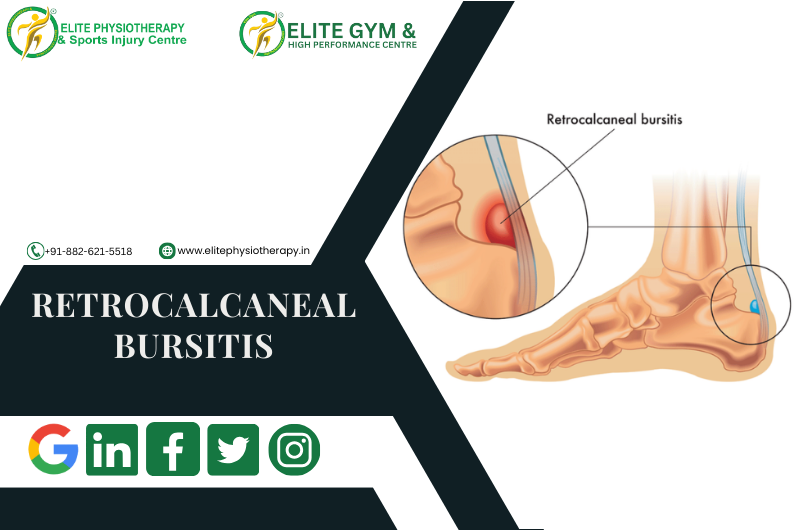What is Retrocalcaneal Bursitis?
The painful inflammatory disease known as retrocalcaneal bursitis affects the bursa between the calcaneus (heel bone) and the Achilles tendon. Athletes and those who perform repetitive tasks that impose excessive tension on the heel are frequently affected by this condition. It can seriously affect everyday activities and mobility if treatment is not received. At Elite Physiotherapy and Sports Injury Centre, we use advanced physiotherapy methods and luxury modalities to diagnose and treat retrocalcaneal bursitis in a comprehensive and sophisticated manner.
Causes and Mechanism of Injury
Repetitive friction and severe pressure on the bursa at the rear of the heel can cause retrocalcaneal bursitis. Among the most common causes are:
- Overuse and Repetitive Stress: The bursa may get irritated by high-impact exercises including jogging, jumping, and abrupt direction changes.
- Inappropriate Footwear: Irritation and inflammation can result from wearing stiff or poorly fitting shoes that rub on the heel.
- Biomechanical Abnormalities: Extreme strain on the Achilles tendon and bursa can result from conditions such as high arches, flat feet, or a changed walking pattern.
- Trauma or Direct Impact: Inflammation may be brought on by a forceful impact to the rear of the heel.
- Underlying Medical Conditions: People who have gout, rheumatoid arthritis, or infections are more likely to develop bursitis.

Signs, Symptoms, and Clinical Features
The following symptoms are frequently seen in people with retrocalcaneal bursitis:
- Pain and tenderness at the back of the heel, especially when walking or doing vigorous activities.
- Swelling, warmth, and redness, in the affected region.
- Increased pain when pushing off the foot or standing on toes.
- Ankle stiffness and limited range of motion, especially in the morning or after extended periods of inactivity.
- Dorsiflexion, or pulling the toes toward the shin, exacerbates the pain.
Diagnosis at Elite Physiotherapy and Sports Injury Centre
To establish the diagnosis and rule out other possible disorders like Achilles tendinitis or Haglund’s deformity, our center conducts a comprehensive physical and functional assessment. Our diagnostic methodology consists of:
Clinical Assessment
- Palpation and Inspection: Examining the afflicted bursa for soreness, redness, and swelling.
- Assessing the ankle joint’s range of motion (ROM): This involves determining how flexible and mobile it is.
- Strength testing: involves determining how strong the Achilles tendon and calf muscles are.
Functional and Special Physiotherapy Tests
We employ specific physiotherapy tests, such as the following, to validate the diagnosis:
- Hoffa’s Test: To determine whether Achilles tendon involvement and underlying soft tissue inflammation are present.
- Arc Sign Test: Distinguishing between bursitis and Achilles tendinopathy.
- Royal London Hospital Test: Assessing Achilles pain and swelling with the Royal London Hospital Test.
- The Silfverskiold Test: Measures tension in the gastrocnemius muscles, which can put too much strain on the bursa.
In certain situations, for a more thorough evaluation, we could suggest imaging tests like MRI or ultrasound.
Physiotherapy Management at Elite Physiotherapy and Sports Injury Centre
At our clinic, we treat retrocalcaneal bursitis using customized, evidence-based physiotherapy plans. Our course of treatment consists of:
1. Management of Pain and Inflammation
- Cryotherapy: Using ice packs to minimize swelling and give instant pain relief is known as cryotherapy.
- Activity Modification: To avoid more aggravation, it is advised to temporarily limit high-impact activities.
2. Advanced Physiotherapy Modalities
We use state-of-the-art techniques to maximize healing and accelerate recovery, such as:
- Shock Wave Therapy: Shock wave therapy uses acoustic waves to encourage tissue repair and alleviate pain.
- CRET Therapy: Promotes inflammation reduction and cellular healing.
- The Super superinductive system (SIS): Uses electromagnetic fields to promote healing, increase circulation, and reduce pain.
- High-Intensity Class 4 Laser Therapy: Enhances tissue repair, lessens pain, and speeds up cellular healing.
- Hydrotherapy: Hydrotherapy includes water-based exercises that increase joint mobility while reducing strain on the injured area.
3. Techniques for Soft Tissue and Manual Therapy
- Myofascial Release: Myofascial release relieves tension in the Achilles tendon and surrounding structures.
- Deep Tissue Mobilization: Improves blood flow and eases tense muscles.
- Joint mobilization: Enhances ankle function and flexibility.
4. Exercises for Therapy
We create specialized workout regimens to regain strength, flexibility, and appropriate biomechanics, such as:
- Stretching exercises: They target the Achilles tendon and calf muscles to release stress.
- Strengthening exercises: To increase stability and lessen bursa strain, focus on the calf, ankle, and foot muscles.
- Proprioception Training: Proprioception training includes exercises for balance and coordination that improve functional mobility and reduce the risk of re-injury.
5. Postural and Biomechanical Adjustment
- Gait Training: Gait training corrects faulty walking habits to lessen undue heel strain.
- Orthotic Recommendations: Providing personalized foot insoles for better pressure distribution and shock absorption is one orthotic recommendation.
- Advice on Footwear: Suggest suitable footwear with supportive arch support and cushioned heels.
Prevention and Long-Term Care
To lower the chance of recurrence, we at Elite Physiotherapy and Sports Injury Centre concentrate on both prevention and treatment methods. We instruct our patients on:
- Appropriate warm-up and cool-down techniques both before and following physical activity.
- Maintaining the lower extremities’ strength and flexibility.
- Gradually increase activity levels to prevent overuse injuries.
- Maintaining appropriate foot alignment requires the use of orthotics and supportive footwear.
Conclusion
If left untreated, retrocalcaneal bursitis can become incapacitating. At Elite Physiotherapy and Sports Injury Centre, we combine cutting-edge physiotherapy methods, upscale modalities, and customized rehabilitation programs to offer a thorough, patient-centered approach to treatment. Our objectives are to guarantee a full recovery, avoid recurrence, and assist our patients in getting back to their regular activities and sports without any restrictions.
For an extensive evaluation and top-notch physiotherapy treatment, come see us right now if you have heel pain and think you may have retrocalcaneal bursitis.

